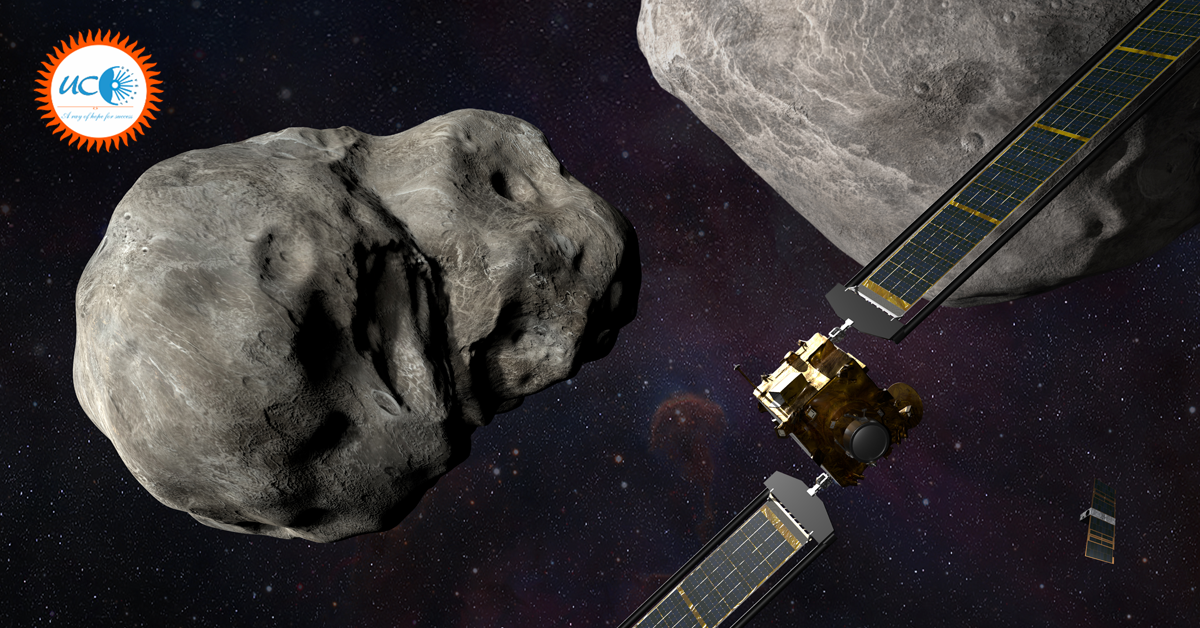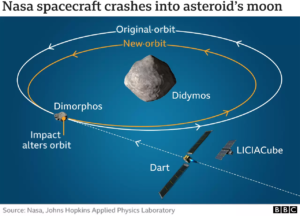Nasa’s Dart spacecraft ‘changed path of asteroid’
The space agency released a raft of data on Tuesday to support its assessment, including new pictures from the Hubble Space Telescope and from a small Italian spacecraft that stood off from the impact by about 50km (30 miles).
Scientists have now confirmed the orbit of a 160m-wide (520ft) space rock known as Dimorphos was altered when the Dart probe struck it head on last month.
Researchers came to the conclusion after making measurements using a range of space and Earth-based telescopes.
The mission was conceived to test a potential strategy to defend the Earth against threatening objects.
About the DART:
DART would be NASA’s first mission to demonstrate what’s known as the kinetic impactor technique – striking the asteroid to shift its orbit – to defend against a potential future asteroid impact.
How it impacts?
The target for DART is an asteroid that will have a distant approach to Earth in October 2022, and then again in 2024. The asteroid is called Didymos – Greek for “twin” -because it is an asteroid binary system that consists of two bodies: Didymos A, about 780 metres in size, and a smaller asteroid orbiting it called Didymos B, about 160 metres in size.
- DART would impact only the smaller of the two bodies, Didymos B. The Didymos system has been closely studied since 2003. The primary body is a rocky S-type object, with composition similar to that of many asteroids.
- The composition of its small companion, Didymos B, is unknown, but the size is typical of asteroids that could potentially create regional effects should they impact Earth. After launch, DART would fly to Didymos and use an APL-developed onboard autonomous targeting system to aim itself at Didymos B.
- Then the refrigerator-sized spacecraft would strike the smaller body at a speed about nine times faster than a bullet, about six kilometres per second. Earth-based observatories would be able to see the impact and the resulting change in the orbit of Didymos B around Didymos A, allowing scientists to better determine the capabilities of kinetic impact as an asteroid mitigation strategy.
- The kinetic impact technique works by changing the speed of a threatening asteroid by a small fraction of its total velocity, but by doing it well before the predicted impact so that this small nudge will add up over time to a big shift of the asteroid’s path away from Earth.
How DART Test was done:
- The Double Asteroid Redirection Test (Dart) took place some 11 million km (7 million miles) from Earth.
- It saw the refrigerator-sized Nasa satellite drive straight into Dimorphos at 22,000km/h (14,000mph), destroying itself in the process.
- The space rock orbits a much larger (780m wide; 2,550ft) object called Didymos. Before impact, the time taken for Dimorphos to make one circuit of its sibling was 11 hours and 55 minutes.
- The telescope evidence now indicates this orbital period has been reduced to 11 hours and 23 minutes – a change of 32 minutes. This corresponds to Dimorphos moving closer into to Didymos by “tens of metres”.







